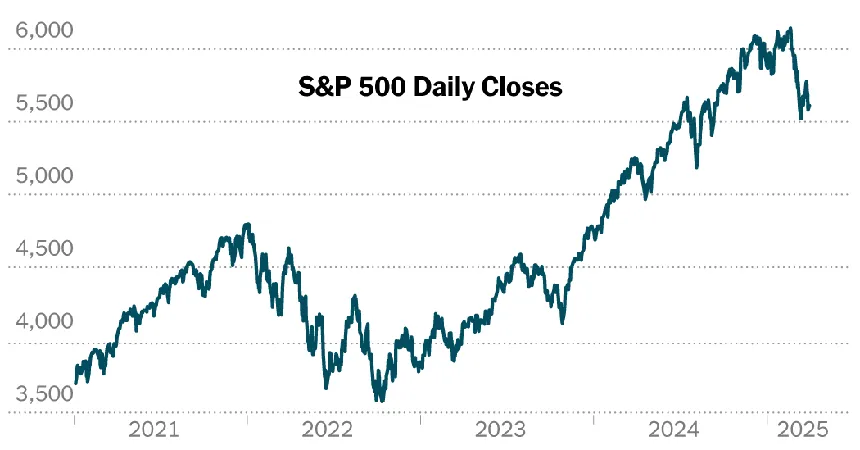
Stock Market Suffers Its Worst Monthly Decline in Years as Trump's Tariffs Create Economic Uncertainty
2025-03-31
Author: Ting
Stock Market Suffers Its Worst Monthly Decline in Years
The S&P 500 wrapped up March with its most significant monthly drop in over two years, driven primarily by investor apprehension regarding President Trump's looming tariffs. These tariffs have raised alarms about accelerating inflation, decreased consumer spending, and a potential stall in U.S. economic growth.
Despite a slight uptick on the final trading day, the index faced a steep 5.8 percent plunge for the month, marking its worst performance since December 2022. This troubling trend not only reflects market volatility but also caps off the worst start to a president's term since Barack Obama assumed office in 2009 during the depths of the financial crisis.
As of now, the S&P 500 has declined by 8.7 percent since its peak in mid-February, nearing a correction, which is typically defined as a drop of 10 percent from recent highs. This downturn has an immediate impact on portfolios and retirement savings across the nation, hitting both Wall Street and Main Street hard. The tech-heavy Nasdaq Composite index has similarly faltered, concluding March with an 8.2 percent drop, having already lost more than 10 percent earlier in the quarter.
Since his inauguration just over two months ago, President Trump has kept both investors and corporations in a state of suspense with his unpredictable 'America First' trade policies. He continues to flip-flop on tariffs, intermittently threatening and delaying their implementation, causing significant volatility in the markets.
As analysts look ahead to Trump's next round of tariff announcements, set for this Wednesday, there are fears that the market could experience further chaotic swings. 'Investors are hoping for clarity after April 2,' commented Steve Sosnick, chief strategist at Interactive Brokers. 'Until then, it’s exceedingly challenging to make investment decisions.'
The euphoric stock market rally that followed Trump's election, fueled by expectations of tax cuts and deregulation, has quickly lost momentum as tariffs have taken precedence in his economic strategy. In a recent interview with NBC’s 'Meet the Press,' Trump acknowledged the potential negative impact on consumers and businesses from new tariffs but remarked, 'I couldn’t care less,' indicating a disregard for the economic consequences.
This uncertainty is compounded by broader issues affecting the labor market, such as Trump's contentious immigration policies. Lauren Goodwin, an economist with New York Life Investments, noted a stark shift in sentiment: 'We went from an economy on the verge of overheating to one facing significant headwinds in just one quarter.'
Goldman Sachs analysts have lowered their forecasts for the S&P 500, citing heightened tariffs, slow economic growth, and rising inflation as key factors. They predict a further 5 percent decline in the index over the next three months, with a one-in-three probability that the U.S. may slip into recession.
Investor anxiety is palpable in reflective market behaviors. The price of gold soared to around $3,150 per ounce, setting a record, as investors typically seek out the yellow metal in periods of market distress. Similarly, safe-haven U.S. government bonds have attracted increased investment, pushing the yield on the 10-year Treasury note down to below 4.2 percent.
In response to these evolving economic conditions, expectations for interest rate cuts by the Federal Reserve are on the rise, with investors anticipating three cuts this year. The Fed is currently standing by, waiting for clearer indicators of how Trump's policies will unfold and their actual impact on consumer and business behavior, with most officials bracing for a dual threat of higher inflation and lower economic growth.
International markets have also felt the tremors from U.S. tariff news, with Japan and Taiwan’s stock markets plummeting by more than 4 percent. In South Korea, shares fell sharply by 3 percent. The Nikkei 225 index in Japan has officially entered correction territory, having decreased by 12 percent from its December high.
Losses across Europe continued as well, with the Stoxx 600 index down 1.5 percent, heavily affected by declines in German automakers like Volkswagen—especially vulnerable to U.S. tariffs—dropping over 3 percent in Frankfurt.
Amidst all this uncertainty, Trump's use of trade tariffs continues to be a focal point of his administration's economic strategy as he seeks to foster domestic investment and innovation. However, his overt disregard for market stability and the repercussions of higher import prices on American consumers leave many investors unsettled.
In a further twist, over the weekend, Trump escalated geopolitical tensions by threatening secondary sanctions on Russia unless it engages in dialogue to halt the conflict in Ukraine. This echoes a previous strategy involving Venezuela, showcasing a broader use of economic pressure in international relations.
As the threat of 25 percent tariffs on imported cars and parts looms closer, along with already delayed tariffs affecting Mexico and Canada, investors brace for further market volatility in the days ahead. The economic landscape is fraught with uncertainty, and how these tariffs will play out remains to be seen. Stay tuned for the latest updates on this developing story.




 Brasil (PT)
Brasil (PT)
 Canada (EN)
Canada (EN)
 Chile (ES)
Chile (ES)
 Česko (CS)
Česko (CS)
 대한민국 (KO)
대한민국 (KO)
 España (ES)
España (ES)
 France (FR)
France (FR)
 Hong Kong (EN)
Hong Kong (EN)
 Italia (IT)
Italia (IT)
 日本 (JA)
日本 (JA)
 Magyarország (HU)
Magyarország (HU)
 Norge (NO)
Norge (NO)
 Polska (PL)
Polska (PL)
 Schweiz (DE)
Schweiz (DE)
 Singapore (EN)
Singapore (EN)
 Sverige (SV)
Sverige (SV)
 Suomi (FI)
Suomi (FI)
 Türkiye (TR)
Türkiye (TR)
 الإمارات العربية المتحدة (AR)
الإمارات العربية المتحدة (AR)